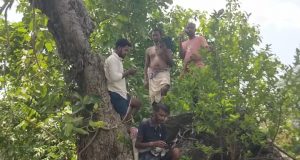Shalachua’s struggle for connectivity

Anandapur: In the remote village of Shalachua, nestled on the edge of Keonjhar’s Anandapur block and abutting Mayurbhanj district, residents are stuck in a time warp. While India rapidly expands its 5G network and works on cutting-edge telecommunication advancements, villagers here climb trees to catch a fleeting mobile signal, a stark reminder of the digital divide plaguing rural areas.
Surrounded by dense forests and hills, Shalachua, largely home to tribal communities, has no mobile towers in or near the village. The absence of basic network access forces locals to scale tall trees, hoping to connect to a weak and unreliable signal. Even then, success is not guaranteed.
“It’s frustrating,” said Durlabh Nayak, a local resident. “We climb, but the network is rarely there.”
The lack of connectivity disrupts daily life. From accessing government schemes to contacting emergency services, residents face constant hurdles. Surrounded by wildlife, the village grapples with the fear of animal attacks, and without reliable communication, reaching the Forest department or medical help during crises is nearly impossible. Students too suffer, unable to access online resources or communicate effectively for their studies. At night, the village falls into what locals call a “mobile blackout,” leaving them completely cut off.
Despite the telecom boom in urban centres and along highways, remote rural pockets like Shalachua remain overlooked by companies competing to expand services.
Villagers, including Kshirod Nayak, Muna Nayak, Rabindra Nayak, Kabindra Nayak, and Ballabh Nayak, demanded action. They’ve called on the administration to install a mobile tower to bring basic communication services and bridge the gap to government programmes.
For now, Shalachua’s residents continue their precarious climbs, chasing signals in the treetops, hoping for a future where connectivity is no longer a distant dream.
News